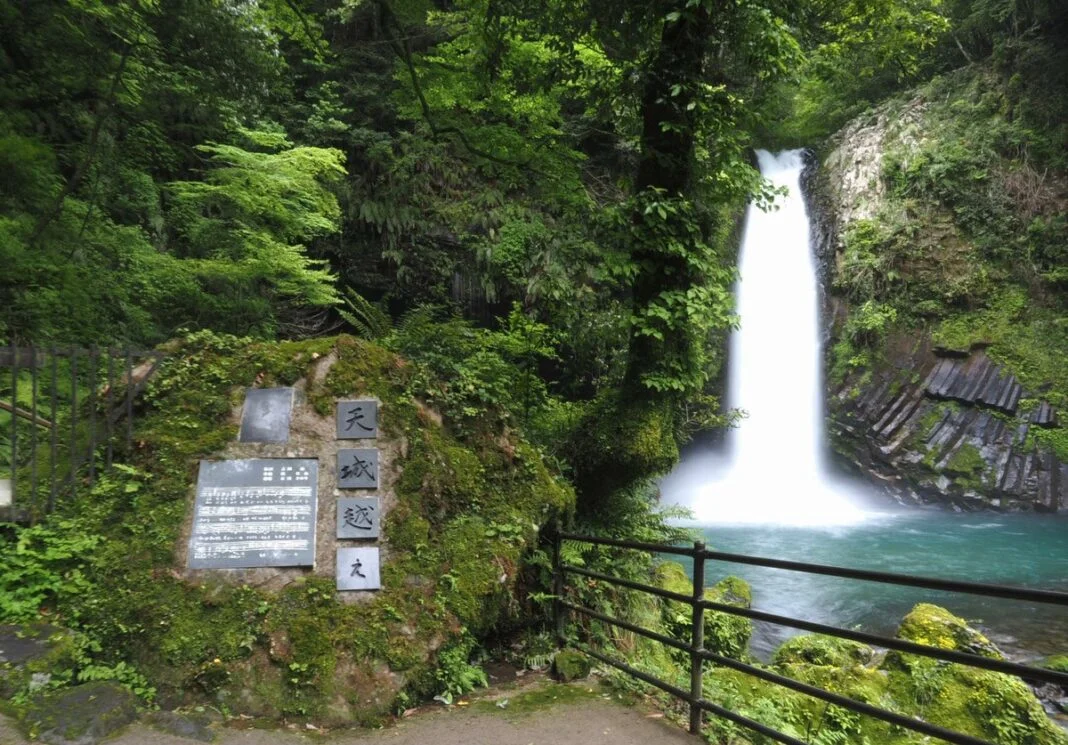Amagi, located in the city of Izu, is a very familiar place for Japanese people, thanks in part to the popular enka song “Amagi-goe”. The Joren Falls is also well-known to many people because its name appears in the lyrics of the song.
Here, we will be introducing the Joren Falls and other spots in Nakaizu, where you can experience the nostalgic natural beauty of Japan, along with the local cuisine nurtured by the clear waters of Amagi and the history of this region.
Joren Falls – Shower yourself with the negative ions of the Izu Peninsula’s most famous waterfall! –
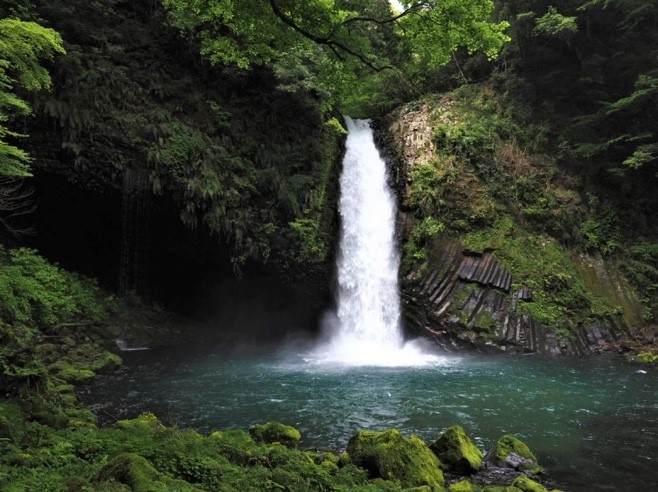
Joren Falls is a prominent scenic spot in Izu and is recognized as a geo-site of the Izu Peninsula Geopark *1 and was selected one of “Japan’s top 100 waterfalls.” The waterfall has a drop of 25 meters, a width of 7 meters, and the depth of the waterfall basin is 15 meters. With the splashing water from the drop, you can feel the negative ions all over your body in the rich nature surrounded by deep trees. Thanks to its abundant and clear water quality, the emerald green waterfall basin is home to a cluster of jeweled chain ferns, a natural treasure that only grows in clean water.
The waterfall was formed when a volcano erupted about 17,000 years ago, and columnar joints (regular cracks in the rocks that form hexagons or other columnar shapes when the lava cools) can be seen in the bedrock on both sides.
As a side note, the name Joren is said to be named after Jorenji Temple, which once stood near the left bank of the waterfall.
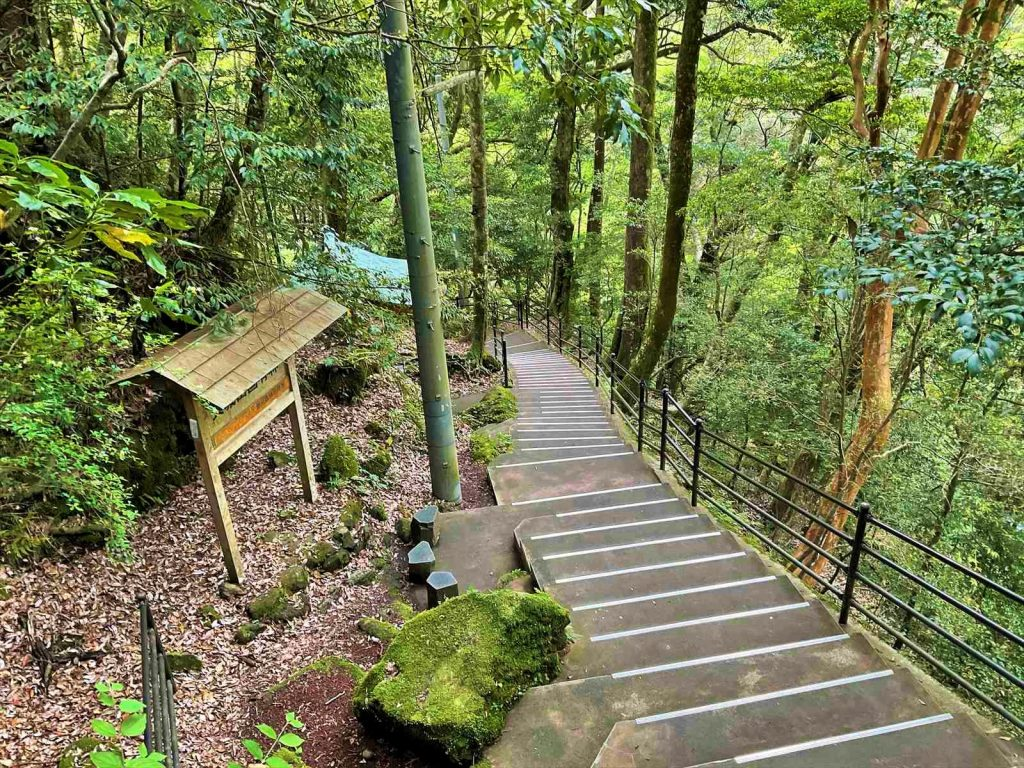
There is a barrier-free observation deck near the parking lot that overlooks the waterfall. From the parking lot, it took about 10 minutes on foot each way to reach the waterfall basin. The path goes up about 200 steps, so it may be a good idea to take a break on the way there.
As you descend down the stairs, you can feel the refreshing splash from the waterfall as well as the intensity of the waterfall. The shape of the bedrock and the flow of water formed by the laws of nature at Joren Falls offered a magnificent experience to feel the power and beauty of the earth.
*1 A geo-site is an attraction within a park, called a geopark, that shows the formation of the earth and is managed according to the concepts of “preservation,” “education,” and “sustainable development” for areas of geological value on an international scale.
Experience mountain stream fishing in the clear waters of Joren Falls! (Amagi Kokusai Masutsuriba)
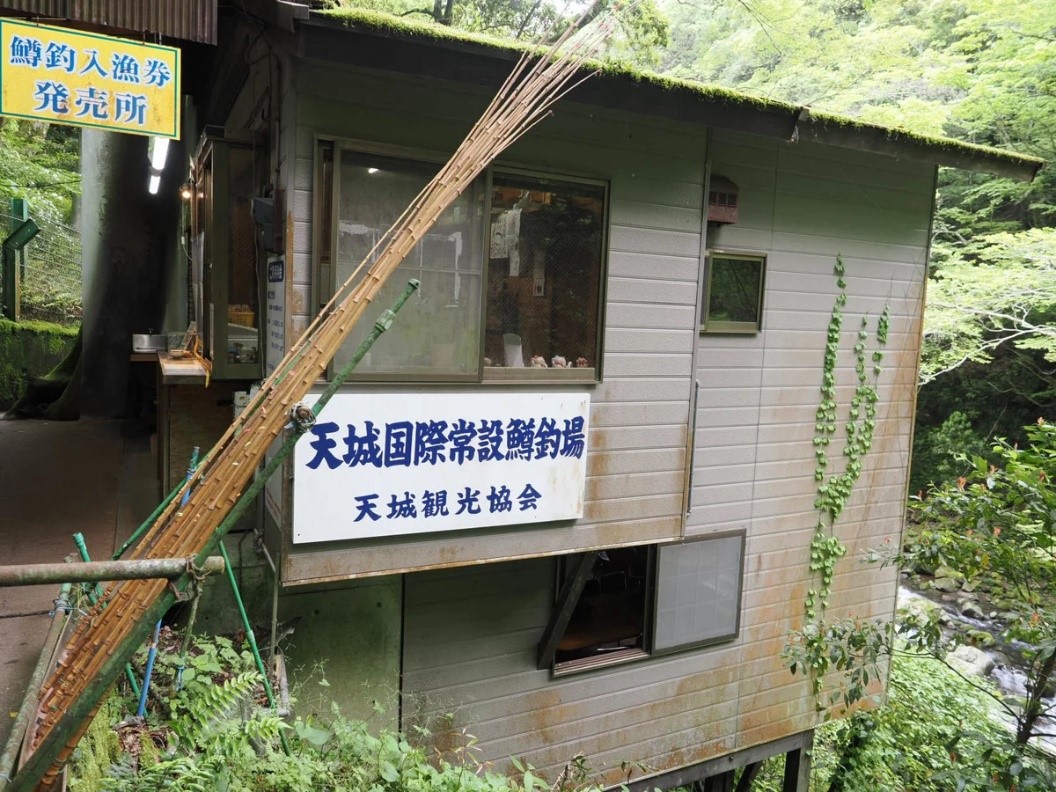
From here, we will introduce some of the highlights of Joren Falls other than the waterfall.
Just downstream of Joren Falls is a permanent trout fishing area using the natural river, where visitors can enjoy mountain stream fishing for rainbow trout, amago, etc. Rental rods, bait, take-out boxes, etc. are provided, so you can have a great time fishing even if you arrive empty-handed. You can even grill the fish you catch and eat it on the spot.
Why not try mountain stream fishing in the great outdoors where you can be showered with negative ions?
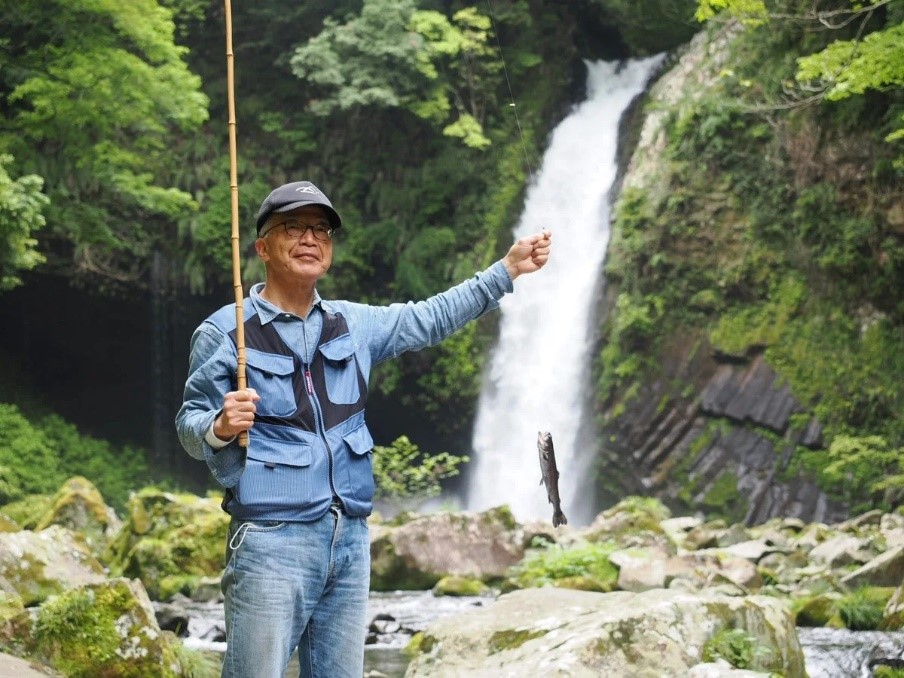
Several fishermen were present on the day of our visit, and one of them caught a nice rainbow trout while we were interviewing him.
When asked for tips on how to fish in a natural river, he replied, “Rainbow trout are often found in areas where the current is slower. Once you find a good spot, you may want to try aiming at them from a distance to avoid alarming them.”
Amago, which are also known as the “queens of the freshwater streams,” are extremely cautious and are normally reserved for advanced fishermen, so those who are confident in their abilities should try their luck at catching them.
The local Amagi specialty “wasabi” is one of the many cuisines that you can only taste here
One of the local specialties of Amagi is “Sawa wasabi”. Sawa wasabi is a high quality variety of wasabi grown in clear streams characterized by its excellent color, aroma, pungency, and sweetness.
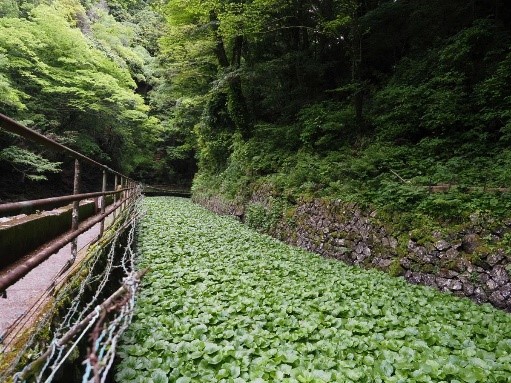
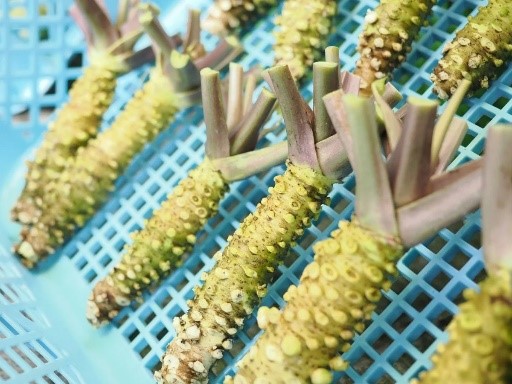
“Mazuma wasabi,” the finest variety of wasabi, is also grown in the Amagi region of Izu. The Mazuma variety is more difficult to grow and takes 1.5 times longer to harvest than the seedling variety, and it is an extremely rare type of wasabi grown only in a few areas in Japan. It is said that they are rarely found in the market, so we highly recommend that you purchase some when you visit Amagi.
Stores selling processed wasabi products can be found in various areas throughout Amagi. Among them, we visited a restaurant called Keyaki for lunch and had a rice bowl with genuine wasabi, followed by the “original wasabi-flavored soft serve ice cream” from Amagi Wasabi no Sato. Both of these dishes are made with an abundance of genuine Japanese wasabi from Amagi.

The wasabi rice bowl is a simple dish consisting of rice topped with dried bonito flakes and wasabi. The wasabi is grated on the spot. The key is to gently grate the wasabi in a circular motion to obtain the best flavor. When grated vertically, it is said to be more pungent.
As the wasabi is grated, a tingling sensation and fresh aroma spreads, whetting your appetite. Finally, pour soy sauce over the top to complete the dish. We felt the unique spiciness of wasabi softly, and finished the dish in no time. You can truly taste the difference between fresh genuine wasabi and the wasabi sold in tubes in stores. It was a simple but luxurious rice bowl meal rich with the aroma and flavor of wasabi.
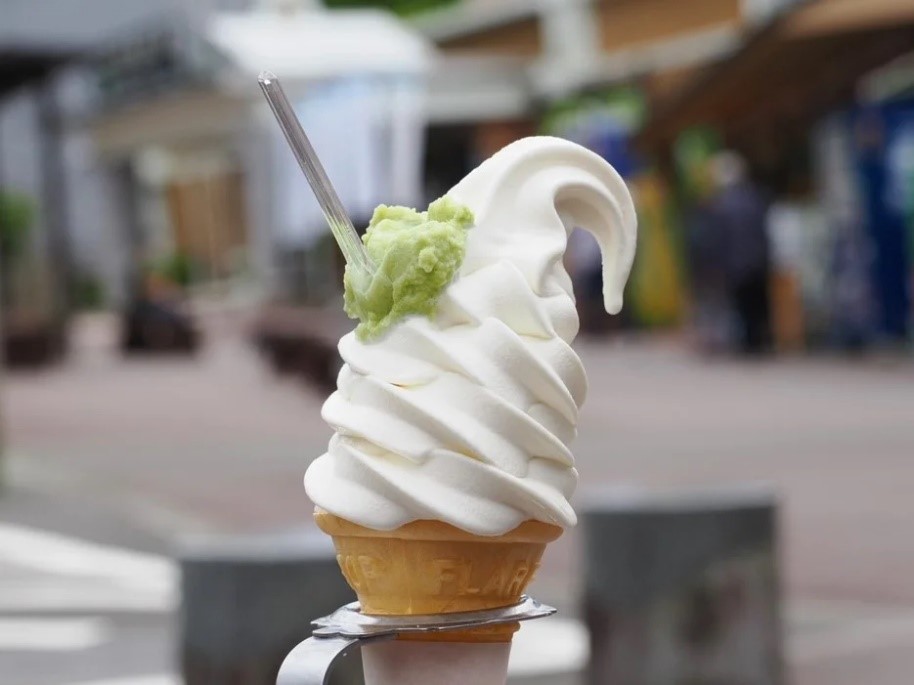
For dessert, we had the “original wasabi-flavored soft serve ice cream” from Amagi Wasabi no Sato. The vanilla soft serve ice cream is actually topped with genuine wasabi, so you can enjoy the richness of the vanilla with the flavor of wasabi.
The rich sweetness of vanilla is gently followed by the refreshing spiciness of the wasabi. This combination went surprisingly well together, and the wasabi finished off the sweetness, so we enjoyed it all the way through.
Wasabi products everywhere at the souvenir section!

As one would expect from a place famous for its wasabi, the souvenir shops was filled with all shades of green. From wasabi furikake (rice seasoning) to wasabi chazuke (seasoning for green tea over rice), wasabi soba noodles, to wasabi beer, this souvenir shop had it all.
On this day, we purchased genuine wasabi and pickled wasabi in an attempt to recreate the wasabi rice bowl we had for lunch at home.
[Joren Falls Tourism Center] https://www.j-taki.com/
Enjoy a short break on your trip at the “Amagi-goe” Roadside Station.

After leaving Joren Falls and heading south on Route 414, we soon arrived at the Amagi-goe Roadside Station, where we stopped by the Showa-no-Mori Kaikan located inside the roadside station. Inside, there is a “Forest Information Center” where visitors can learn more about the great nature of Amagi, from its origins to the details of how it came to be.

At the neighboring “Izu Museum of Modern Literature” (admission fee required), you can find items and personal effects of more than 120 writers who are related to Izu, including a manuscript of the novel “The Dancing Girl of Izu” by Yasunari Kawabata, one of Japan’s most leading authors, making this a must-visit spot for fans of Japanese literature.
If you’re in the mood for a snack, head to the concession stand!

At the Amagi-goe Roadside Station, visitors can also enjoy other culinary delights unique to Amagi at restaurants such as “Yama no Restaurant Midori no Mori,” which serves dishes made from wild game and local specialties, and “Takenoko Kaasan no Mise” where small side dishes made from local vegetables are sold.
This time, we enjoyed the shiitake mushroom croquettes at “Takenoko Kaasan no Mise”. The croquettes are rich in flavor and deliciousness and are made with luxurious log-grown shiitake mushrooms. The batter is crispy and the inside is moist and fluffy, making it a popular dish among both children and adults.
[Amagi-goe Roadside Station]
https://www.cbr.mlit.go.jp/michinoeki/shizuoka/shizuoka07.html
Amagi-san Zuido Tunnel (Former Amagi Tunnel) – An Important Cultural Property from the Meiji Era where you can feel a mystical sense of wonder –

After lunch, we left the Amagi-goe Roadside Station and made our way to the Amagi-san Zuido Tunnel. The Amagi-san Zuido Tunnel, which is also the setting for Kawabata Yasunari’s “The Dancing Girl of Izu,” was opened in 1905 and connected Amagiyugashima Town to Kawazu Town, and is the longest of the stone road tunnels (445.5 m in length), as well as the first road tunnel designated as a National Important Cultural Property.

As we drove through the primeval forest of Mt. Amagi, we spotted the literary monument dedicated to “The Dancing Girl of Izu” along the way. Further ahead, a tunnel with an imposing appearance appears.
Inside the tunnel is a quiet, dimly lit space. This mysterious and somewhat mystical tunnel, which still retains an exotic atmosphere of the Meiji period, has been used many times as a filming location for movies.

The tunnel can be accessed by car, but this time we decided to walk through it on foot. The walls of the tunnel, which are made of stone, are covered with moss, and you can feel its history that spans more than 110 years. Inside the tunnel, the road is dotted with incandescent light bulbs, and the cool, clear air constantly flows from the direction of Kawazu Town, making it feel as if you traveled back in time.
Izu City Tourist Information: http://kanko.city.izu.shizuoka.jp/form1.html?pid=2481
Namesawa Gorge – Sculptures of rock formations created by water and clear streams sliding down monolithic rocks –
Next, we headed to Namesawa Gorge, located about 1 km toward Kawazu from the “Amagi-goe Roadside Station,” where Yasushi Inoue, an author who spent his childhood in Yugashima in Izu, wrote his first novel ” The Hunting Gun”. A literary monument featuring a line from “The Hunting Gun” was erected on the walking trail along the gorge.
Namesawa Gorge was formed when the Namesawa Volcano erupted, and the lava that flowed into the valley cooled and hardened into a sheet of rock, creating a canyon where the river flowed over the bedrock.

Namesawa Gorge, with its beautiful flowing water, is like a natural water sculpture created by nature. The water is constantly chipping away at the surface of the rocks, so they will surely have a different appearance in a few hundred years and will continue to provide fresh impressions for future generations.
Izu City Tourist Information: http://kanko.city.izu.shizuoka.jp/form1.html?pid=2511
Ryushi Falls – A dragon covered with bedrock scales –
The Ryushi Falls are located at the point where the Hontani river joins from Namesawa Gorge. It is said that this waterfall was named after the rock formations next to the waterfall basin, which have been carved and formed to look like the face of a dragon emerging from the surface of the water.
The appearance of the dragon is not the flow of the waterfall, so please pay attention to the rock next to the waterfall basin.

The rugged bedrock of the gorge resembles the scales of a dragon, evoking a scene in which a lone dragon is resting by the waterfall.
Izu City Tourist Information: http://kanko.city.izu.shizuoka.jp/form1.html?pid=3390
Summary
Amagi, located in the center of the Izu Peninsula, still retains a nostalgic atmosphere, and we were able to refresh our body and soul with the surrounding lush greenery of the mountains and clear streams.
Although not introduced here, Amagi is an area that we would recommend to those who want to spend a relaxing time in a quiet natural setting away from the hustle and bustle of the city, as well as for watching fireflies in the summer and for its famous hot springs.
Why not stay in Amagiyugashima Onsen-kyo district, enjoy the local delicacies of Amagi such as wasabi, shiitake mushrooms, wild game meat, and wild mountain vegetables, and take a tour of the healing clear stream spots?
